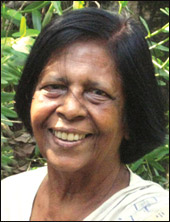Bringing out the internal dialogue
 In
each of us, when awake (and often when asleep), some kind of
consciousness is always going on. There is a stream, a succession of
states, or waves, or fields or of whatever you please to call them, of
knowledge, of feeling, of desire, of deliberation, etc., that constantly
pass and re-pass, and that constitute our inner life. In
each of us, when awake (and often when asleep), some kind of
consciousness is always going on. There is a stream, a succession of
states, or waves, or fields or of whatever you please to call them, of
knowledge, of feeling, of desire, of deliberation, etc., that constantly
pass and re-pass, and that constitute our inner life.
Stream of consciousness is literary technique which seeks to describe
an individual’s point of view by giving the written equivalent of the
character’s thought processes. It is regarded as a special form of
interior monologue and is characterized by associative (and at times
dissociative) leaps in syntax and punctuation that can make the prose
difficult to follow, tracing as they do a character’s fragmentary
thoughts and sensory feelings. In stream of consciousness, the speaker’s
thought processes are more often depicted as overheard or addressed to
oneself.
|

Eva Ranaweera |
Stream of Consciousness is a literary technique which was pioneered
by Dorothy Richardson, Virginia Woolf, and James Joyce. A towering
figure in the modernist literary period, James Joyce is considered the
most prominent English-speaking writer of the first half of the
twentieth century.
While he wrote in a number of genres, including drama and lyric
poetry, Joyce’s reputation rests primarily on his prose works. Joyce’s
novels, including A Portrait of the Artist as a Young Man (1916) and
Ulysses (1922), are widely considered ground-breaking works of fiction
which not only fundamentally redefined the novel as a genre, but pushed
the limits of the English language itself.
Joyce is among the most widely-read and studied figures in the
history of English literature, and is often considered as significant a
talent as John Milton and William Shakespeare.
Joyce is one of the most thoroughly read and analyzed authors in
English literature. Numerous and varied interpretations of his work
abound; critics have provided religious, feminist, socio-political,
historical, sexual, and autobiographical perspectives on his fiction.
His brilliant and innovative utilization of language remains a recurring
interest of literary critics, as is Joyce’s use of humour. Literary
critics note that his life has come to symbolize the spiritual
alienation of the modern artist, and his work has spawned numerous
imitations.
A complicated artistic genius, he created a body of work worthy of
comparison with the masterpieces of English literature. His literary
influence is considered profound, and such writers as Samuel Beckett,
William Faulkner, Thomas Pynchon, and John Irving are regarded as his
literary descendants.
From Sri Lanka, one may be able to add another name to this list of
writers, who followed Joyce in their works. The writer is Eva Ranaweera.
Eva is the first woman writer who brought stream of consciousness into
Sinhala literature. The credit of introducing the stream of
consciousness into Sinhala novel goes to Siri Gunasinghe in his novel
“Sevenalla” (The Shadow), but Eva was the writer who used in profoundly
and more meaningfully.
For, the stream of consciousness has been used as a narrative form in
all her four of novels. In fact, she excelled in this technique. There
are many reasons for her expertise in this form of narrative style.
Chief among them was that James Joyce who was the pioneer in this style
was her favourite author. She had read Joyce’s “Ulysses” not once but
several times.
Eva shows up an excellence in deriving colloquial Sinhala in the form
of stream of consciousness. It was always a great meeting point of a
genre and theme. Eva brings out feelings and emotions of the ordinary
village lasses in both her books ‘Laisa’ and ‘Sedona’, keeping their
consciousness alive to the readers.
The technique allows her to dive into their lives, capture their
desires and present them in the best way. If Eva wished to write in
favour of women and how they become victims in a male dominated society,
the wishes have been fulfilled because of the positive method of
presentation. Both ‘Laisa’ and ‘Sedona’ face to emotional turbulences
over their love lives, and secrecy matters, so no one else there for
them for refuge other than their own consciousness.
Eva has conquered the technique of the stream of consciousness as a
best practice in feminist literature. |



